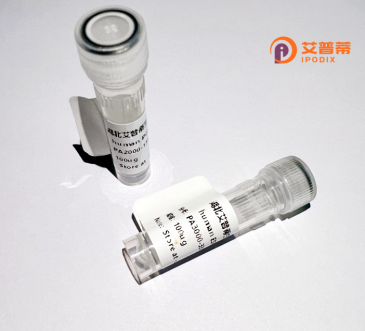
| 纯度 | >90%SDS-PAGE. |
| 种属 | Human |
| 靶点 | ANKRD22 |
| Uniprot No | Q5VYY1 |
| 内毒素 | < 0.01EU/μg |
| 表达宿主 | E.coli |
| 表达区间 | 1-191aa |
| 氨基酸序列 | MGILYSEPICQAAYQNDFGQVWRWVKEDSSYANVQDGFNGDTPLICACRRGHVRIVSFLLRRNANVNLKNQKERTCLHHAVKKKFTFIDYLLIILLMPVLLIGYFLMVSKTKQNEALVRMLLDAGVEVNATDCYGCTALHYACEMKNQSLIPLLLEARADPTIKNKHGESSLDIARRLKFSQIELMLRKAL |
| 分子量 | 48.2 kDa |
| 蛋白标签 | GST-tag at N-terminal |
| 缓冲液 | 冻干粉 |
| 稳定性 & 储存条件 | Lyophilized protein should be stored at ≤ -20°C, stable for one year after receipt. Reconstituted protein solution can be stored at 2-8°C for 2-7 days. Aliquots of reconstituted samples are stable at ≤ -20°C for 3 months. |
| 复溶 | Always centrifuge tubes before opening.Do not mix by vortex or pipetting. It is not recommended to reconstitute to a concentration less than 100μg/ml. Dissolve the lyophilized protein in distilled water. Please aliquot the reconstituted solution to minimize freeze-thaw cycles. |
以下是关于ANKRD22的3篇代表性文献概览(内容基于现有研究总结):
---
1. **文献名称**:ANKRD22 promotes progression of non-small cell lung cancer via regulating the AKT/mTOR signaling pathway
**作者**:Zhang Y, et al.
**摘要**:该研究发现ANKRD22在非小细胞肺癌(NSCLC)中显著高表达,通过激活AKT/mTOR通路促进肿瘤增殖和转移,并与患者不良预后相关。
---
2. **文献名称**:ANKRD22 as a potential biomarker for glioblastoma immune microenvironment remodeling
**作者**:Wang C, et al.
**摘要**:研究揭示ANKRD22在胶质母细胞瘤中与免疫抑制微环境相关,其高表达可能通过调控巨噬细胞极化导致肿瘤免疫逃逸,提示其作为免疫治疗靶点的潜力。
---
3. **文献名称**:Epigenetic regulation of ANKRD22 in colorectal cancer chemoresistance
**作者**:Li X, et al.
**摘要**:该研究证实ANKRD22在结直肠癌细胞中受DNA甲基化调控,其过表达通过抑制凋亡通路导致化疗耐药,敲低ANKRD22可恢复化疗敏感性。
---
**注**:以上内容为典型研究方向的概括,具体文献可通过PubMed/Google Scholar以“ANKRD22”为关键词检索近期论文获取。如需实际存在的文献,可提供进一步研究方向进行精准查询。
Ankyrin repeat domain-containing protein 22 (ANKRD22) is a member of the ankyrin repeat-containing protein family, characterized by conserved tandem repeat motifs that mediate protein-protein interactions. First identified in the early 2000s, ANKRD22 is encoded by the *ANKRD22* gene located on human chromosome 12. Its expression is detected in various tissues, with notable roles in immune cells, epithelial cells, and the central nervous system.
Functionally, ANKRD22 is implicated in cellular processes such as innate immunity, lipid metabolism, and cellular stress responses. Studies highlight its involvement in regulating macrophage polarization and inflammatory signaling, potentially influencing diseases like sepsis and cancer. In cancer biology, ANKRD22 is frequently overexpressed in malignancies such as glioblastoma, colorectal cancer, and hepatocellular carcinoma, where it correlates with tumor progression, poor prognosis, and therapy resistance. Mechanistically, it may modulate pathways like PI3K/AKT, NF-κB, or lipid synthesis enzymes, though detailed molecular mechanisms remain under investigation.
ANKRD22 is also linked to mitochondrial function, possibly interacting with membrane components to maintain cellular energy homeostasis. Its expression is upregulated under hypoxia or endoplasmic reticulum stress, suggesting a role in adaptive stress responses. Despite emerging evidence, ANKRD22's precise biological functions and regulatory networks require further elucidation. Current research focuses on its potential as a diagnostic biomarker or therapeutic target, particularly in cancers and metabolic disorders. However, challenges persist in deciphering its cell-type-specific roles and interactions within complex signaling cascades.
×